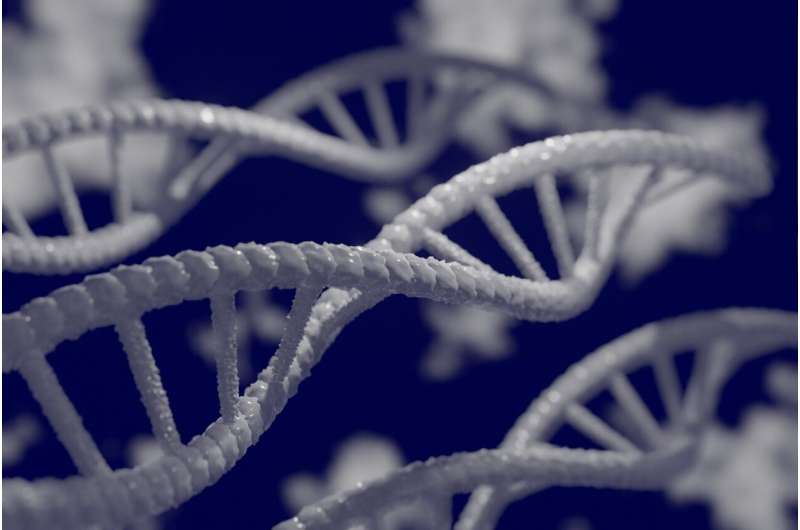A new genetic mapping study led by researchers at the Johns Hopkins Bloomberg School of Public Health traces links between DNA variations and thousands of blood proteins in two large and distinct populations. The results should help researchers better understand the molecular causes of diseases and identify proteins that could be targeted to treat these diseases.
The study included more than 9,000 Americans of European or African ancestry, and generated maps of DNA-to-protein links for both groups. The study is thought to be the first of its kind to include two large and ancestrally distinct population cohorts. Proteins play a critical role in cellular function, and changes in protein mechanisms—often regulated by DNA variations—can lead to disease. DNA-to-protein mapping could help explain differences in the rates of some diseases in the two groups and help researchers understand some health disparities.
The study appears in Nature Genetics.
Researchers have been mapping the molecular roots of human diseases for decades through so-called genetic mapping studies. The best known is the genome-wide association study (GWAS). A GWAS typically links variations in DNA to disease risk by analyzing the DNA of subjects—often tens or hundreds of thousands of individuals at a time—along with their history of a given disease. This uncovers statistical associations linking the disease to specific DNA variations.
Missing from the GWAS picture: Most of the disease-linked DNA variants identified by GWAS analysis do not lie within protein-coding genes. Researchers therefore assumed that many—even most—disease-linked DNA variants affect proteins indirectly, by regulating one or more steps in the gene-to-protein production process, thereby altering protein levels. Linking diseases directly to proteins, researchers can better understand the roots of disease—and also identify protein targets for disease prevention and treatments.
“This relatively new kind of mapping study provides a wealth of information that will allow researchers to test for potential links of proteins on various types of health outcomes—risk of cancers, heart disease, severe COVID—and help to develop or repurpose therapeutic drugs,” says study senior author Nilanjan Chatterjee, Ph.D., Bloomberg Distinguished Professor in the Department of Biostatistics at the Bloomberg School.
To demonstrate the DNA-protein mapping’s application, the researchers used it to identify an existing rheumatoid arthritis drug as a plausible new treatment for the common joint-pain disorder known as gout.
The study was a collaboration between Chatterjee’s team and the research group of Josef Coresh, MD, George W. Comstock Professor in the Bloomberg School’s Department of Epidemiology and one of the paper’s co-authors, and colleagues at several institutions.
The analysis covered 7,213 Americans of European ancestry and 1,871 African Americans in the long-running Atherosclerosis Risk in Communities (ARIC) study, headed by Coresh; and 467 African Americans from the African American Study of Kidney Disease and Hypertension (AASK). In both of these studies, the research teams had sequenced the genomes of the participants and recorded bloodstream levels of thousands of distinct proteins.
For their mapping study, Chatterjee’s team analyzed the ARIC and AASK genomic data to identify more than two thousand common DNA variations that lie close to the genes encoding many of these proteins and correlate with the proteins’ bloodstream levels.
“The value of knowing about these DNA variants that predict certain protein levels is that we can then examine much larger GWAS datasets to see if those same DNA variants are linked to disease risks,” Chatterjee says.
Using a European-American dataset, they found that it predicted several proteins whose levels would influence the risk of gout or bloodstream levels of the gout-related chemical urate. These proteins included the interleukin 1 receptor antagonist (IL1RN) protein, which appears to lower gout risk—a finding that suggests the existing rheumatoid arthritis drug anakinra, which mimics IL1RN, as a plausible new therapy for gout.
Having data from both white and Black Americans allowed the researchers to map protein-linked DNA variants more finely than if they had been restricted to one or the other. The African-ancestry models generated in the study will allow future analyses of how different populations’ genetic backgrounds might contribute to differences in disease rates.
“We know that prostate cancer risk, for example, is higher in African American men, so in principle, one could combine prostate cancer GWAS data on African Americans with our protein data to identify proteins that contribute to elevated prostate cancer risk in that population,” Chatterjee says.
The team has made its datasets and protein prediction models publicly available online so researchers can use the resource. Chatterjee’s team and collaborators anticipate doing further studies in the ARIC and AASK cohorts, as well as in other diverse cohorts, to gather information on proteins and other factors that influence the DNA-to-disease chain of causality.
Related article:
Protein Pilfered from Cancer Cells Thwarts Immune Attack
Study Nearly Doubles Known Cancer-Linked Mutational Signatures


